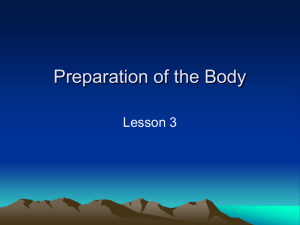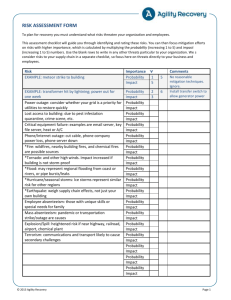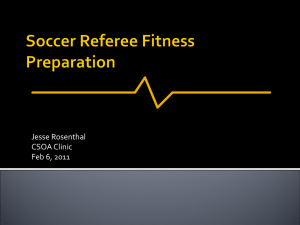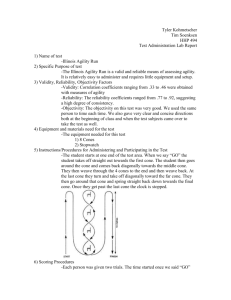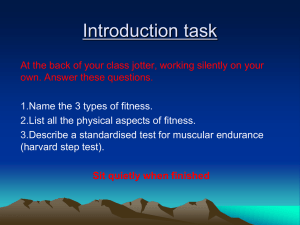Average
advertisement
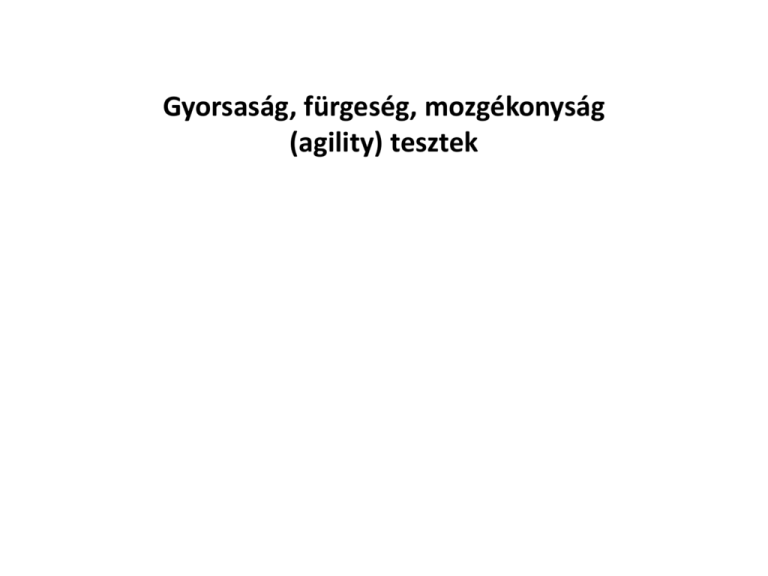
Gyorsaság, fürgeség, mozgékonyság (agility) tesztek Kondicionális képesség gyorsaság képesség a mozgások lehető legnagyobb sebességgel történő végrehajtására adott feltételek mellett. Koordinációs képesség fürgeség térbeli tájékozódás ritmus Sheppard and Young (2006) képesség a test mozgási sebességének és irányának gyors (hirtelen) megváltoztatására valamilyen jel hatására. Képesség a testhelyzet hatékony megváltoztatására, amelyhez az izolált mozgások integrációjára van szükség, egyfajta kombinációja az egyensúlynak, koordinációnak, gyorsaságnak reflexeknek, erőnek, állóképességnek.. Reakcióidő Pozicionálási gyorsaság Mozdulatgyorsaság Mozgásgyorsaság Eszközök Stopper óra Fénykapú Lézerkapú radar Tapping teszt 25 érintés 25 érintés 60 cm Ütési sebesség Futógyorsaság Time to run 35 meters (in seconds) rating men women very good < 4.80 < 5.30 good 4.80 - 5.09 5.30 - 5.59 average 5.10 - 5.29 5.60 - 5.89 fair 5.30 - 5.60 5.90 - 6.20 poor > 5.60 > 6.20 * for Australian team sport players Teljes test fürgeség Páros lábbal ugrás a vonalakon át 10 mp-ig Értékelés: minden helyesen végrehajtott ugrásért egy pont. Hibás ugrásért 0,5 pont levonás reference: Johnson, B.L.; Nelson, J.K., (1986) Quadrant Jump Test [NonRunning Type Agility Test]. Side-Step Test 30 cm 1 perces ugrás poor fair average good high Female <33 34-37 38-41 42-45 46+ Male <37 38-41 42-45 46-49 50+ Side-Step Test The side step test is a simple fitness test of agility. equipment: flat, non-slip floor, with line markings (can use masking tape), tape measure, stopwatch procedure: Subject stands at a center line, then jumps 30cm to the side (e.g. right) and touches a line with the closest foot, jumps back to the center then jumps 30 cm to the other side, then back to the center. This is one complete cycle. The subject tries to complete as many cycles as possible in one minute. poor fair average good high Female <33 34-37 38-41 42-45 46+ Male <37 38-41 42-45 46-49 50+ scoring: One complete cycle is recorded as 1, and half a cycle as 0.5. The score is expressed as the number of repetitions in one minute. Some normative values are presented below. reference: Many years ago when this page was created, the reference was recorded as Song (1982). I have not been able to find further details, this may be a book reference. Hexagon Agility Test Folyamatos ugrás a vonalakon keresztül háromszor órajárással megegyezően és ellentétesen. Hexagon Agility Test aim: This is a test of the ability to move quickly while maintaining balance. equipment required: tape measure, chalk or tape for marking ground, stopwatch procedure: Using athletic tape, mark a hexagon (six sided shape) on the floor. The length of each side should be 24 inches (60.5 cm), and each angle should work out to be 120 degreees. The person to be tested starts with both feet together in the middle of the hexagon facing the front line. On the command 'go', they jump ahead across the line, then back over the same line into the middle of the hexagon. Then, continuing to face forward with feet together, jump over the next side and back into the hexagon. Continue this pattern for three full revolutions. Perform the test both clockwise and anticliockwise. scoring: The athletes score is the time taken to complete three full revolutions. The best score from two trials is recorded. Comparison of the anticlockwise and clockwise directions will show if any imbalances exist between left and right movement skills. advantages: This is a simple agility test to perform, requiring limited equipment and space. disadvantages: Only one person can perform the test at a time. comments: If you jump the wrong line or land on a line then the test is to be restarted 505 Agility Test Állórajttal indul A mért idő az utolsó 5 m + a fordulás utáni 5 m, azaz 10 m. Ismétlés kétszer. Mindkét irányban fordulás. Illinois Agility Test Futás irányváltással Agility Run Ratings (seconds) Rating Males Females Excellent < 15.2 < 17.0 Good 16.1-15.2 17.9-17.0 Average 18.1-16.2 21.7-18.0 Fair 18.3-18.2 23.0-21.8 Poor > 18.3 > 23.0 Agility Shuttle Run Test 10 m Agility Shuttle Run Test This test describes the procedure as used in the President's Challenge Fitness Awards. The variations listed below give other ways to also perform this test. purpose: this is a test of speed and agility, which is important in many sports. equipment required: wooden blocks, marker cones, measurement tape, stopwatch, non-slip surface. procedure: This test requires the person to run back and forth between two parallel lines as fast as possible. Set up two lines of cones 30 feet apart or use line markings, and place two blocks of wood or a similar object behind one of the lines. Starting at the line opposite the blocks, on the signal "Ready? Go!" the participant runs to the other line, picks up a block and returns to place it behind the starting line, then returns to pick up the second block, then runs with it back across the line. See Shuttle Agility Test video scoring: Two or more trails may be performed, and the quickest time is recorded. Results are recorded to the nearest tenth of a second. variations / modifications: The test procedure can be varied by changing the number of shuttles performed, the distance between turns (see the similar 10 meter shuttle) and by removing the need for the person pick up and return objects from the turning points. advantages: this test can be conducted on large groups relatively quickly with minimal equipment required. comments: the blocks should be placed at the line, not thrown across them. Also make sure the participants run through the finish line to maximize their score. 30 feet = 9.144 meters Zig Zag Test Zig Zag Test equipment required: marker cones, stopwatch, nonslip surface. procedure: Similar to the Shuttle Run test, this test requires the athlete to run a course in the shortest possible time. A standard zig zag course is with four cones placed on the corners of a rectangle 10 by 16 feet, with one more cone placed in the centre. If the cones are labelled 1 to 4 around the rectangle going along the longer side first, and the centre cone is C, the test begins at 1, then to C, 2, 3, C, 4, then back to 1. modifications: This test procedure can be modified by changing the distance between cones, and the number of circuits performed. comments: The total distance run should not be too great so that fatigue does not become a factor. Agility T-Test Males (seconds) Females (seconds) Excellent < 9.5 < 10.5 Good 9.5 to 10.5 10.5 to 11.5 Average 10.5 to 11.5 11.5 to 12.5 Poor > 11.5 > 12.5 Agility T-Test purpose: the T-Test is a test of agility for athletes, and includes forward, lateral, and backward running. equipment required: tape measure, marking cones, stopwatch, timing gates (optional) diagram: procedure: Set out four cones as illustrated in the diagram above. The subject starts at cone A. On the command of the timer, the subject sprints to cone B and touches the base of the cone with their right hand. They then turn left and shuffle sideways to cone C, and also touches its base, this time with their left hand. Then shuffling sideways to the right to cone D and touching the base with the right hand. They then shuffle back to cone B touching with the left hand, and run backwards to cone A. The stopwatch is stopped as they pass cone A. scoring: The trial will not be counted if the subject cross one foot in front of the other while shuffling, fails to touch the base of the cones, or fails to face forward throughout the test. Take the best time of three successful trials to the nearest 0.1 seconds. The table below shows some scores for adult team sport athletes. Males (seconds) Females (seconds) Excellent < 9.5 < 10.5 Good 9.5 to 10.5 10.5 to 11.5 Average 10.5 to 11.5 11.5 to 12.5 Poor > 11.5 > 12.5 comments: Ensure that the subjects face forwards when shuffling and do not cross the feet over one another. For safety, a spotter should be positioned a few meters behind cone A to catch players in case they fall while running backward through the finish. reliability: the type of surface that is used should be consistent to ensure good test-retest reliability advantages: This is a simple agility test to perform, requiring limited equipment and space. disadvantages: Only one person can perform the test at a time. Males (seconds) Females (seconds) Excel lent < 9.5 < 10.5 Good 9.5 to 10.5 10.5 to 11.5 Aver age 10.5 to 11.5 11.5 to 12.5 Poor > 11.5 > 12.5 Labdarúgók tesztje 2x Arrowhead Agility Drill 2x Arrowhead Agility Drill This test measures the agility of the athlete, especially body control and change of direction, commonly used for testing soccer players. This test is part of the assessment battery for SPARQ soccer, and their protocol is listed here. purpose: this is a test of speed, explosion, body control and the ability to change direction over a range of angles and directions. equipment required: stopwatch or timing gates, measuring tape or or chalk for marking the ground, 6 marker cones, a flat non-slip surface. procedure: The cones are laid out as per the diagram, with three marker cones placed in a arrowhead shape, and one set of cones or line marker to indicate the start and finish line. The player starts with their foot behind the starting line in a sprint start position. When ready, they run as fast a possible to the middle cone (A), turn to run around the side cone (C) or (D), around the far cone (B) and back through the start/finish line. The subject completes four trails, two to the left then two to the right (as shown). The trail does not count if they step over a cone instead of around it. Labdarúgók Box Drill Fitness Test oldalazó futás Előrefelé futás Hátrafele futás Előrefelé futás 10 yard (9,1 m) Box Drill Fitness Test This test used to be part of the testing battery for the NFL Combine, before being replaced by the 3-Cone Drill. purpose: this is a test of agility, including speed, quickness, flexibility, change of direction and body control. equipment required: stopwatch, measuring tape, 4 marker cones, a flat non-slip surface procedure: Four marker cones are placed 10 yards apart in a square configuration (see diagram). The player starts by getting down in a three-point stance next to Cone 1. On the command 'Go', he sprints to cone 2, then shuffles sideways to cone 3. From there you back-pedal to cone 4 and finish by turning and sprinting through and finishing at cone 1. The athlete must go around the outside of each cone. scoring: The time to complete the test in seconds is recorded. The score is the best time of two trials. target population: This test used to be part part of the NFL testing combine, though it would be suitable for athletes involved in many team sports where agility is important such basketball, hockey, rugby, soccer. comments: The the “4 Cone” or “Box” drill has been replaced by the 3-Cone Drill in the NFL scouting combine. scoring: Record the best time to complete the test for the left and right turning trails. The time is recorded in seconds to the nearest two decimal places for each direction. target population: used for testing soccer players, though it would be suitable for sports where agility is important comments: Turning technique and coordination is also a large factor in this test. 8 Foot Up and Go Test (időseknek) bólya szék 2,4 m Jones & Rikli, 2002 Férfiak Age below average average above average 60-64 > 5.6 5.6 to 3.8 < 3.8 65-69 > 5.7 5.7 to 4.3 < 4.3 70-74 > 6.0 6.0 to 4.2 < 4.2 75-79 > 7.2 7.2 to 4.6 < 4.6 80-84 > 7.6 7.6 to 5.2 < 5.2 85-89 > 8.9 8.9 to 5.3 < 5.3 90-94 > 10.0 10.0 to 6.2 < 6.2 Nők Age below average average above average 60-64 > 6.0 6.0 to 4.4 < 4.4 65-69 > 6.4 6.4 to 4.8 < 4.8 70-74 > 7.1 7.1 to 4.9 < 4.9 75-79 > 7.4 7.4 to 5.2 < 5.2 80-84 > 8.7 8.7 to 5.7 < 5.7 85-89 > 9.6 9.6 to 6.2 < 6.2 90-94 > 11.5 11.5 to 7.3 < 7.3 8 Foot Up and Go Test (időseknek) The '8 Foot Up and Go' is a coordination and agility test for the elderly, which is part of the Senior Fitness Test Protocol. See also the AAHPERD agility test also designed to test agility in the elderly. purpose: This test measures speed, agility and balance while moving. equipment required: stopwatch, straight back or folding chair (about 17 inches/44 cm high), cone marker, measuring tape, area clear of obstacles. procedure: Place the chair next to a wall (for safety) and the marker 8 feet in front of the chair. Clear the path between the chair and the marker. The subject starts fully seated, hands resting on the knees and feet flat on the ground. On the command, "Go," timing is started and the subject stands and walks (no running) as quickly as possible (and safely) to and around the cone, returning to the chair to sit down. Timing stops as they sit down. Perform two trials. scoring: Take the best time of the two trails to the nearest 1/10th second. Below is a table showing the recommended ranges in seconds for this test based on age groups (from Jones & Rikli, 2002). target population: the aged population which may not be able to do traditional fitness tests. comments: For best results, practice the test once, and then perform it twice. A cane or walker may be used if that is the usual mode of walking. Push-off from the chair is allowed. references: Rose D., Jones C., Lucchese N.: Predicting the Probability of Falls in Community-Residing Older Adults Using the 8-Foot Up and- Go: A New Measure of Functional Mobility. J Aging & Physical Activity, Oct 2002; 10, 4. Jones C.J., Rikli R.E., Measuring functional fitness of older adults, The Journal on Active Aging, March April 2002, pp. 24–30. Anna Różańska-Kirschke, Piotr Kocur, Małgorzata Wilk, Piotr Dylewicz, The Fullerton Fitness Test as an index of fitness in the elderly, Medical Rehabilitation 2006; 10(2):
